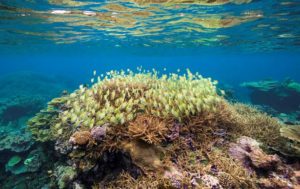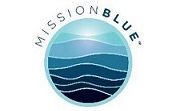Research Expedition Set for Pristine Atoll Palmyra Led by Dr. Jennifer Caselle

A school of Manini (convict tangs) swim across the colorful coral reefs at Palmyra Atoll. Photo by Tim Calver ©
From November 1st to November 5th, The Nature Conservancy led an expedition to a pristine Atoll named Palmyra to conduct research to learn more about how healthy functioning marine ecosystems function best. Expedition team leader, Dr. Jennifer Caselle will be accompanied by Baum Foundation President Glenn Bucksbaum, photographer Michael Garland, and 5 Gyres President Marcus Eriksen. The Palmyra Atoll is a Northern Pacific atoll located 1,000 miles south of Hawaii. In 2000, The Nature Conservancy acquired the atoll for research and conservation purposes and now shares ownership of the atoll with the U.S. Fish and Wildlife Service. In 2001, the Palmyra Atoll was designated as a National Wildlife Refuge. Palmyra Atoll is an important place for research of marine conservation as it is a pinnacle example of pristine coral reef health. This offers researchers and scientists the rare opportunity to study thriving marine habitats, being virtually untouched by humans.
Leading the expedition is Dr. Jennifer Caselle, a research biologist with the University of California, Santa Barbra. Dr. Caselle’s research is focused on marine conservation and reef ecology and, while at Palmyra, her team will be researching connections between apex predators and ecosystem health. In order to conduct her research, Jennifer will be tagging sharks using acoustic telemetry to study their movements.
5 Gyres co-founder Dr. Marcus Eriksen will also be conducting water sampling experiments while at Palmyra Atoll, testing for toxins and microplastics. 5 Gyres is an organization dedicated to ending plastic pollution in the ocean. Marcus hopes that this research will not only help his ongoing investigations of small microplastic distribution worldwide. One of the main goals of the research is to help develop new plastic monitoring methods and the equipment to detect plastics in our water. Since then, Eriksen has devoted his life to the problem. Beginning in 2010, 5 Gyres spearheaded a series of scientific firsts by researching plastic in all five subtropical gyres, as well as the Great Lakes and Antarctica sailing a total of 50,000 miles in the process.
In 2014, under Eriksen’s direction, 5 Gyres convened eight scientists around the world to publish the first global estimate of plastic pollution in our ocean: 5.25 trillion particles weighing in at 2 69,000 tons of “plastic smog” worldwide. Eriksen’s co-authored paper on plastic microbead pollution in the Great Lakes inspired a two-year collaborative campaign that culminated in a federal ban on microbeads, which President Obama signed into law in 2015. In August 2016, Eriksen led 5 Gyres’ 17th expedition this time to research microplastics and nanoplastics above the Arctic Circle.
vvlx,
hentai,
xporn,
xnxx,
sex việt,
Family Practice Doctors Near Me,
Ratify Treaties,
Best Hookup Apps,
Brunch On A Wednesday,
Comfortzone,
Plaza Premium Lounge Orlando Reviews,
Catering 77002,
Cauliflower And Coconut Curry,
Usa Rail Pass,
Active Duty Service Member,
Patch American Flag,
Farfetch Coupon Code,
Connect Google Mini,
Nike Mens High Top,
Bronny James Usc Basketball,
Anal Sex Prep,
Aesports,
Check Balance On Debit Card,
Add People Trustpilot,
Skype Ids,
← Sites Unseen, Exhibition Launched, Featured in San Francisco Chronicle
5 Gyres Institute Concludes its 17th Research Expedition to the Canadian Arctic →




